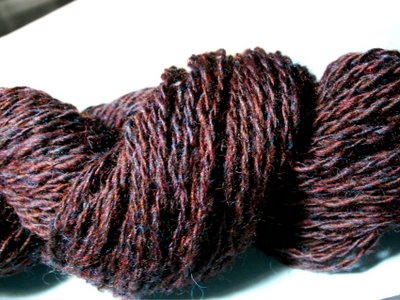 Fiber: Ashland Bay Multi Mahogany Top
Fiber: Ashland Bay Multi Mahogany TopSpindle: "Hearts" from Woolly Designs
Spindle spun singles, spindle plied, 2-ply.
 The color is a little "bleh" for me. I don't dislike brown. But this one is not working for me. Not sure what I can knit/make with it.
The color is a little "bleh" for me. I don't dislike brown. But this one is not working for me. Not sure what I can knit/make with it.The photo on the left shows (from left to right) KnitPicks' "Shadow" lace weight, "Mahogany", KnitPicks' "Essential Tweed" fingering weight, and Trekking XXL fingering weight. So, I'd say that I have a fingering weight yarn here.
I took the photo to compare the thickness of the yarn. But I couldn't help but notice the differences in the look of them. Do you see what I mean? The two on the left are 2-ply and the two on the right are 4-ply. 2-ply yarn looks more textured than the 4-ply yarn. This didn't surprise me since I recently had discussions with Randall from the guild and Ted the Oracle about what kind of yarn is more suitable for textured knitting. (Don't hit me, Ted. hehehe) But it was really interesting to see it with my eyes instead of just understanding it in my head.
If you take a bucketful of sand and a bucketful of gravel. Smooth out the top and look at them. The sand would have a smoother surface and the gravel a more textured surface. The reason is that sand is smaller and has less space in between each grain of sand. Gravel is larger and has more space in between. I hope this is making sense.
Now look at the yarn. Two yarn with the same weight, one 2-ply, one 4-ply. 2-ply yarn has two strands of larger singles, 4-ply has four strands of smaller singles. The 2-ply looks more textured because of the larger singles and the bigger space it has in between the singles when plied. It's more bumpy. The 4-ply with samller singles have smaller space in between the singles. It's a smoother look. Phew! I am really wordy. But I am not done. LOL Still make sense?
The amount of the twist can also affect the look. Look at KnitPicks' "Shadow" and my "Mahogany". I am not sure how to say this. "Shadow" has more twist. More twist seems to squeeze out more space and make the yarn appear to be less bumpy. Know what I mean? I look at my yarn and I know I will want to add more twist to my singles in the future, so there will be more twist when I ply them. That is if I want less bumpy yarn.
Another thing to consider when plying is that 2-ply yarn is more "flat", 3-ply yarn is more "round" and 4-ply yarn is more "square". But I am not so sure if it is correct to describe them as such. I must read "The Alden Amos Big Book of Handspinning" from cover to cover. I am sure all that stuff is in there.
So, if I want to do textured knitting like cables, I will want less textured yarn to show off the texture of the fabric. 3-ply or 4-ply will probably be better choices. Hmmm... I think I've convinced myself to try Navajo-plying ASAP! LOL
I untwisted some yarn to see how they were plied. I took photos of them. Here they are:
Yarn that I've used for textured knitting with success. 1) Plymouth "Encore Worsted", 3-ply. 2) KnitPicks' "Wool of the Andes", 4-ply.
Yarn I have used or am using for lace shawl. 3) KnitPicks' "Shadow", 2-ply. 4) KnitPicks' "Palette", 2-ply.
Ted, I know I know. I've said that I didn't want to get "technical" when I start spinning. Guess I just couldn't help it. It's fun to look at things this way.Fingering weight sock yarn. 5) KnitPicks' "Essential", 4-ply. 6) KnitPicks' "Essential Tweed", 4-ply. 7) Trekking XXL, 4-ply.
Sylvia, you really know my brain better than I do. LOL








5 comments:
This is a great post! Very educational - I understood the basic information already but never thought about yarn construction much.
Dear jason,
You don't sound like a "casual" spinner to me :) Alot of people who knit cables tend to want a smooth and relatively firm yarn that,when knit into cables, will stand up away from the base in high releif. The biggest bang for your knitting buck! Most also do not want it to be multi-coloured because that detracts from the clean sculptural quality of cables. Of course I don't follow any of that but you catch my drift! I'm not at all technical about spinning/plying. I just spin it until I get what I want. If I don't get what I want I just use what I get!
Good Luck with the continued spinning. Remember, the more skilled, the more you are obliged to teach. Just ask poor Ted!
I'm confused. So if I want to doa cabled sweater, I ought to be looking at 3 ply over 2?
Really interesting stuff here! :)
(I've been reading the Amos book, its so neat!)
Thank you all! :-) This really is about new discovery. I don't know about it being educational. LOL I only hope that it's understandable. :-)
Micah, after looking at the differences in yarn and having knitted a swatch of my hand-spun yarn, I would recommend using at least a 3-ply if you want to do cables. In the book "Hats On!", Charlene Schurch recommended 3-ply yarn for an Aran Watch Cap. I didn't understand why. Now I think I do. :-)
Post a Comment